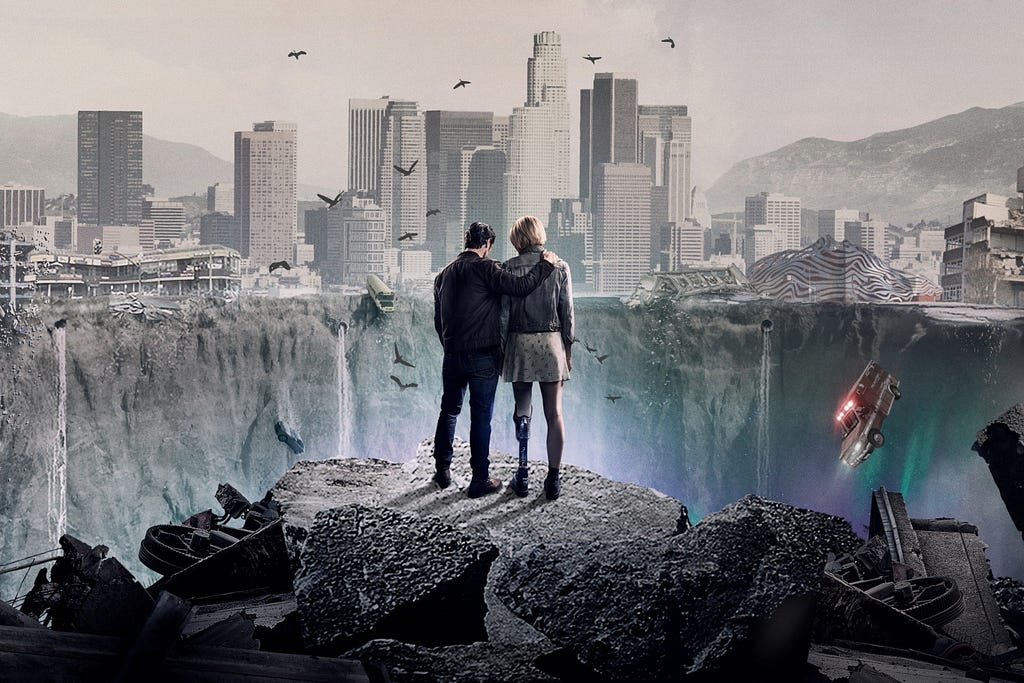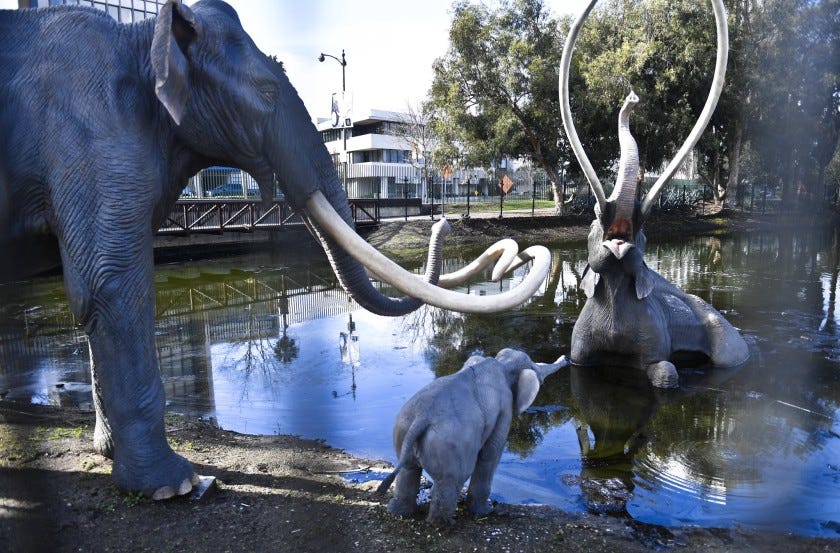
La Brea Pilot Analysis #2: How to use different POVs to improve world-building and immerse your audience Photo by NBCUniversal Media
Photo by NBCUniversal Media
Remember Lost? It was the TV sensation that millions (me included) obsessed over — and the show that La Brea is partly modeled after. But La Brea isn’t simply a copycat. The writers chose to tweak two important aspects of the Lost formula that differentiates this new show from its predecessor: the relationship between its central characters, and how it introduces its fictional world.
On Lost, its main characters — Jack, Kate, Sawyer, John Locke, etc. — were mostly strangers who had no prior relationship to each other. Thus, in the first few episodes, their interactions with each other were very limited emotionally.
SPOILERS BELOW for La Brea’s pilot episode. You can watch it for free on Peacock here.
By contrast, La Brea is centered around a family of four — Eve, Gavin, Izzy and Josh — who are immediately torn apart. Two fall into the sinkhole world, while the other two remain above ground in LA.
Because of their tight familial bond, these characters bring soooo much more emotion to their interactions. They care for each other on a much deeper level, and that endears these characters to the audience far more than simply watching a group of strangers. So much so that we begin to eagerly root for them to be reunited as a family again, as I’d highlighted in my La Brea Pilot Analysis #1:
Introducing Likeable Characters in the Opening 5 Minutes
The second area where La Brea differs from Lost is in its world-building. Lost uses the traditional method of introducing its mythical world using just that one perspective: the passengers who crashed onto its strange, remote island. La Brea could’ve easily done the same, by having the entire family fall into the sinkhole, then focusing solely on that strange, primeval world.
Instead, La Brea gets far more ambitious, by utilizing three different perspectives to introduce its world to us:
Sinkhole world — survivorsReal world — Homeland SecurityFamily — Gavin/Izzy
How does adding two other perspectives vastly improve viewer immersion into this imaginary sinkhole world? And where does this method — which I liked so much I’m calling it the “Layer Cake” method! — fit into the 3 step framework for world-building?
Step #1: Make it real Photo by Stuart Palley for Los Angeles Times
Photo by Stuart Palley for Los Angeles Times
The first step to world-building is to make a fictional world feel as REAL as possible. Here, the show opens with a shot of the La Brea Tar Pit attraction — smack in the middle of LA. The writers used a real world landmark as the center of their sinkhole — complete with giant mastodon statues — which adds tremendously to the realism.
Once the cracks in the ground started, I felt the special effects of the sinkhole swallowing up every car, building, and person was so well done that I totally believed it might happen!
Believability? Check.
Step #2: Selectively release information
The second step is to selectively reveal bits and pieces of your brand new imaginary world to your audience. The goal here is to give them enough breadcrumbs to increasingly reel them in more and more into your world, at a pace that doesn’t overwhelm them. Give your audience enough time to process each new bit of information or surprising twist.
La Brea takes this even further, by layering three different perspectives into its world-building:
Sinkhole world — Eve, Josh and other survivors’ point of view (POV)Real world — Homeland Security agents’ POVFamily — Gavin and Izzy’s POV
By adding the latter two perspectives into the mix — both firmly grounded in the real world of LA — La Brea is able to add even more realism and believability to its premise.
In addition, because each storyline feels soooo different from the others, this actually elicits even more intrigue from the audience. Each time the show cut away from one perspective to another — especially when cutting away from the sinkhole world — I eagerly anticipated going back.
The biggest benefit of La Brea’s layering technique is to use its different perspectives to build an even richer mythical world for its viewers to savor and enjoy.
Building a ‘Layer Cake’ Photo by Annie Spratt on Unsplash
Photo by Annie Spratt on Unsplash
Each time the show cut to a different perspective, we learned new information that helped us piece together the full picture of exactly what this sinkhole world is. Even better, many of these new reveals were information that the other POVs could never offer. Without these different perspectives, it would be nearly impossible to know such crucial details:
Real world — government agents have seen this green light beforeFamily — Gavin digs up Eve’s ring necklace that she’d lost in sinkhole worldSinkhole world — Eve realizes she’s still in LA, after finding Hollywood Hills
So how exactly did the writers achieve such an elaborate “layer cake” of world building? This is my favorite part: breaking down an episode in order to reverse-engineer its storytelling secrets!
‘Layer Cake’ of alternating perspectives:Sinkhole — Eve finds her son Josh with the other survivors. Why are all the cars smashed to pieces, but the humans survived without a scratch?Real world — Homeland Security announces publicly that they’re not sending a rescue mission, but privately reveal they’ve seen this strange green light beforeFamily — Gavin sees vultures fly out of sinkhole (the same ones from his vision), then has another vision that Eve and Josh are alive!Sinkhole — survivors get attacked by giant wolves, Josh is woundedFamily — Gavin realizes he’d seen the boulder with the bloody handprint on it before, and goes to dig up Eve’s ring-necklaceReal world — Homeland Security sends a drone through the green light, but it loses signal. The vultures are identified as long being extinctFamily — Gavin has vision of crashed drone, tries to talk to Homeland Security agents, but they shut him downSinkhole — shot of older bearded man wearing an animal pelt with the bloody handprint … ends with Eve seeing Hollywood Hills and realizing they’re still in LA. Cliffhanger of saber-toothed tiger!
By alternating between three different perspectives, the writers are able to offer viewers a richer 360 degree panorama of information that they otherwise would’ve never gotten, had the story only focused on the sinkhole world.
This full immersion reeled me in deeper into their fictional world, making me far more intrigued and invested in the story as a result.
Now you can see why I’d named it the “Layer Cake” method! The added perspectives act like additional layers of a cake. Instead of just tasting soft yellow cake, you now have the added variety and crunch of nuts, cream, and fruits too. All of those additional perspectives/layers really does make the whole cake/world taste creamier and yummier as a result! 😜
Step #3: Mystery that hooks us
Now that you’ve hooked your audience into your realistic new world, the third and final step of world-building is to create a juicy mystery or massive conflict that will keep your audience coming back for more. Here, La Brea takes a page out of the Lost handbook for creating a giant season-long mystery.
But how do you create a mystery that will both offer just enough vague, overarching answers that will satisfy viewers enough to not feel completely lost, yet still dangle enough questions over their heads to get them to eagerly return for more answers?
La Brea achieves this in two parts. First, it offers enough clues throughout its pilot episode to answer the most urgent question from viewers: what exactly is this sinkhole world??
By the end of the episode, we get our first answer: Eve, Josh and the survivors have been transported by the green light into prehistoric LA.
Cool! So it’s not a question of where they are, but rather when. The first part of creating a mystery is achieved. The trick now is to make sure this first answer is still vague enough that it opens up even more follow-up questions in your viewers’ minds, such as:
What is prehistoric LA like?Why did that green light appear here, and what happened at Mojave?Will the survivors be able to find a way home?Recap: 3 step framework to world-buildingMake it feel REALDole out selective bits of info/clues at a pace that won’t overwhelm audience. Layer different perspectives for even richer world-building and immersive viewingCreate mystery (or conflict) that hooks audience to come back
This pilot has been a treasure trove of storytelling lessons for me, acing two very difficult things to get right in the opening of any story:
Making us care about its central characters in the first 5 minutesReeling us into its strange new made-up world
Now the real test comes in Episode 2. Will it be able to retain viewers’ interest to keep watching for the entire season?
If you’ll like to hear my thoughts on Episode 2 and beyond, or chat with me about the show, come join me on Twitter! 😃
For more of my movie/TV storytelling tips, check out my Shang-Chi analysis:
Shang-Chi Analysis #2: Best vs. Worst Scenes Masterclass
Dancy Fu is a writer and learning experience designer. She has been analyzing movies, TV shows, novels and screenplays for more than 16 years, collecting storytelling insights to improve her own writing and online courses (on what else, storytelling! 🙂 Dancy has lived in 8 different cities, and currently calls Los Angeles home.
3 Step Guide to Richer, Layered World-Building was originally published in The Writing Cooperative on Medium, where people are continuing the conversation by highlighting and responding to this story.
Read more: writingcooperative.com
